
Tortoises are reptiles of the family Testudinidae of the order Testudines. Like other turtles, tortoises have a shell to protect from predation and other threats. The shell in tortoises is generally hard, and like other members of the suborder Cryptodira, they retract their necks and heads directly backward into the shell to protect them.

The Lacertidae are the family of the wall lizards, true lizards, or sometimes simply lacertas, which are native to Afro-Eurasia. It is a diverse family with at about 360 species in 39 genera. They represent the dominant group of reptiles found in Europe.

Anguidae refers to a large and diverse family of lizards native to the Northern Hemisphere. Common characteristics of this group include a reduced supratemporal arch, striations on the medial faces of tooth crowns, osteoderms, and a lateral fold in the skin of most taxa. The group is divided into two living subfamilies, the legless Anguinae, which contains slow worms and glass lizards, among others, found across the Northern Hemisphere, and Gerrhonotinae, which contains the alligator lizards, native to North and Central America. The family Diploglossidae was also formerly included. The family contains about 87 species in 8 genera.
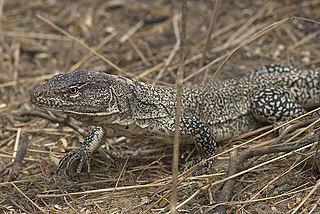
Callopistes is a lizard genus in the family Teiidae. It includes two extant species, which are native to Ecuador, Peru and Chile.
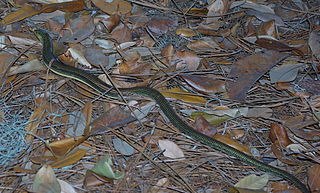
Ophisaurus is a genus of superficially snake-like legless lizards in the subfamily Anguinae. Known as joint snakes, glass snakes, or glass lizards, they are so-named because their tails are easily broken; like many lizards, they have the ability to deter predation by dropping off part of the tail, which can break into several pieces, like glass. The tail remains mobile, distracting the predator, while the lizard becomes motionless, allowing eventual escape. This serious loss of body mass requires a considerable effort to replace, and can take years to do so. Despite this ability, the new tail is usually smaller than the original.

Balaenoptera is a genus of rorquals containing eight extant species. Balaenoptera comprises all but two of the extant species in its family ; the genus is currently polyphyletic, with the two aforementioned species being phylogenetically nested within it.

Blue-tongued skinks comprise the Australasian genus Tiliqua, which contains some of the largest members of the skink family (Scincidae). They are commonly called blue-tongued lizards or simply blue-tongues or blueys in Australia or panana in Indonesia. As suggested by these common names, a prominent characteristic of the genus is a large blue tongue that can be bared as bluff-warning to potential enemies. The type of predator/threat that is near will determine the intensity of colour present in the tongue. The tongue can also deform itself and produce a thick mucus in order to catch prey. They are relatively shy in comparison with other lizards, and also significantly slower due to their shorter legs.

Myotragus is an extinct genus of goat-antelope in the tribe Caprini which lived on the Balearic Islands of Mallorca and Menorca in the western Mediterranean until its extinction around 4,500 years ago. The fossil record of Myotragus on the Balearic Islands extends over 5 million years back to the early Pliocene on Mallorca, where it presumably arrived after the evaporation of the Mediterranean Sea during the Messinian Salinity Crisis.
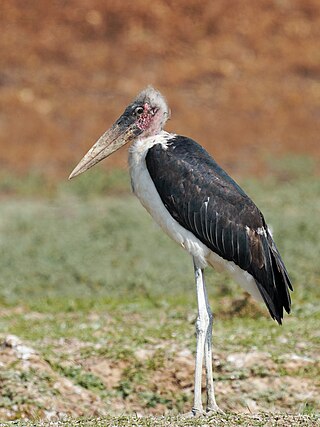
Leptoptilos is a genus of very large tropical storks, commonly known as adjutants. The name means thin (lepto) feather (ptilos). Two species are resident breeders in southern Asia, and the marabou stork is found in Sub-Saharan Africa.

Dopasia gracilis, known commonly as the Asian glass lizard, the Burmese glass lizard, or the Indian glass snake, is a species of legless lizard in the family Anguidae. The species is endemic to Asia.

Nuralagus is an extinct genus of leporid, with a single species, Nuralagus rex, described in 2011. It lived on Menorca, one of the Balearic Islands in the western Mediterranean during the Pliocene epoch. It is the largest known lagomorph to have ever existed, with an estimated weight of 8–12 kilograms (18–26 lb), nearly double the weight of the average Flemish Giant rabbit. It likely went extinct at the Pliocene-Pleistocene transition when Mallorca and Menorca were united as one island, letting the mammalian fauna of Mallorca, including the goat-like ungulate Myotragus, colonize Nuralagus's habitat.

Carcharias is a genus of mackerel sharks belonging to the family Odontaspididae. Once bearing many prehistoric species, all have gone extinct with the exception of the critically endangered sand tiger shark.

Asoriculus is an extinct genus of terrestrial shrews in the subfamily Soricinae and tribe Nectogalini, native to Europe and North Africa.
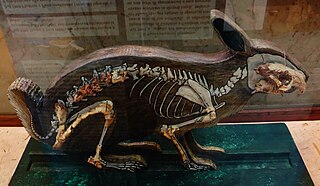
Hypolagus is an extinct genus of lagomorph, first recorded in the Hemingfordian of North America. It entered Asia during the early Turolian and spread to Europe not much later, where it survived until the Middle Pleistocene. Though unknown in the Iberian Peninsula, fossils of this genus have been found in the Balearic Islands, suggesting an eastern migration during the dry period in the Mediterranean region known as the Messinian Salinity Crisis.

Pangshura is a genus of geoemydid turtles endemic to South Asia. Its member species were formerly in the obsolete genus Kachuga. A fifth member, Pangshura tatrotia, was described in 2010, but it is only known from Pliocene fossils.

Hypnomys, otherwise known as Balearic giant dormice, is an extinct genus of dormouse (Gliridae) in the subfamily Leithiinae. Its species are considered examples of insular gigantism. They were endemic to the Balearic Islands in the western Mediterranean from the Early Pliocene until their extinction around 4,000 years ago. They first appeared in the fossil record on Mallorca during the Early Pliocene, presumably due to the Messinian salinity crisis causing a connection with mainland Europe. They later spread to Menorca, and a possible molar is also known from Ibiza. Hypnomys became extinct during the Holocene after human arrival on the Balearics. They were one of only three native land mammals to the islands at the time of human arrival, alongside the shrew Nesiotites and goat-antelope Myotragus.
Pterodromoides is an extinct genus of fulmarine petrel dating from the Late Miocene. It contains a single species, P. minoricensis. Its fossil remains were first discovered at the Punta Nati palaeontological site on the island of Menorca in the Balearic archipelago of the western Mediterranean. An additional specimen from North Carolina, USA has also been referred to this species, suggesting it lived across the North Atlantic. It was described in 2001, with the authors justifying the creation of a new genus by the large orbitonasal opening and characters of the postcranial skeleton, despite the similarity of the cranial osteology to that of Pagodroma.

Miocochilius is an extinct genus of small notoungulate mammals (typotheres) native to South America. The genus lived during the Middle Miocene epoch. The genus contains two described species, the type species M. anomopodus described in 1953 by Ruben Arthur Stirton and M. federicoi, described and included in the genus by Darin A. Croft.

Dopasia hainanensis, the Hainan glass lizard, is a species of lizard of the Anguidae family. It is endemic to Hainan Island in China.
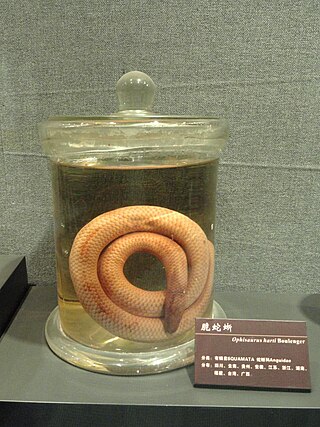
Dopasia harti, also known commonly as the Chinese glass lizard and Hart's glass lizard, is a species of lizard in the family Anguidae. The species is native to southeastern Asia.



















